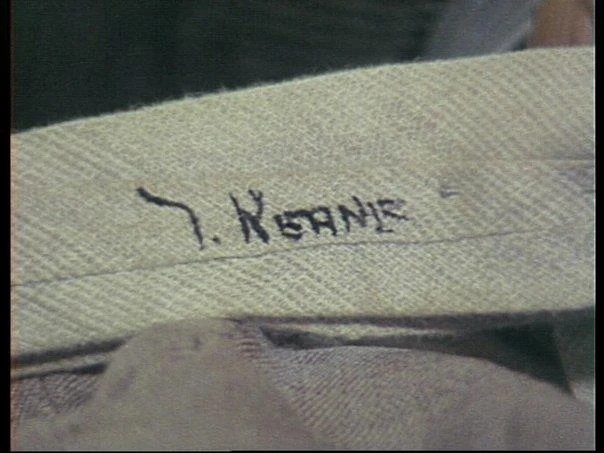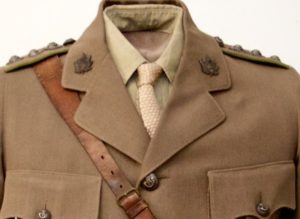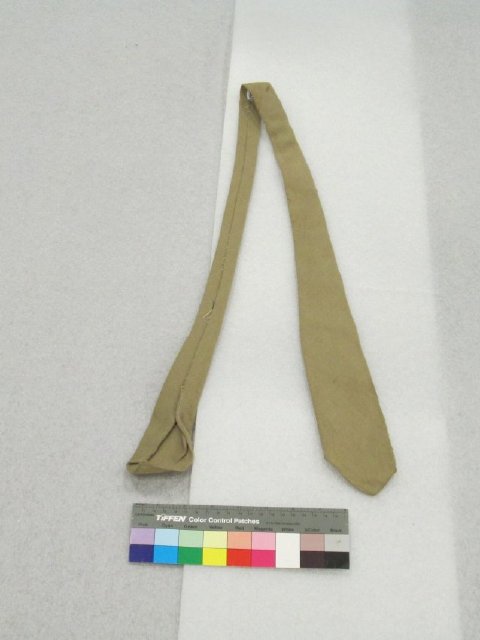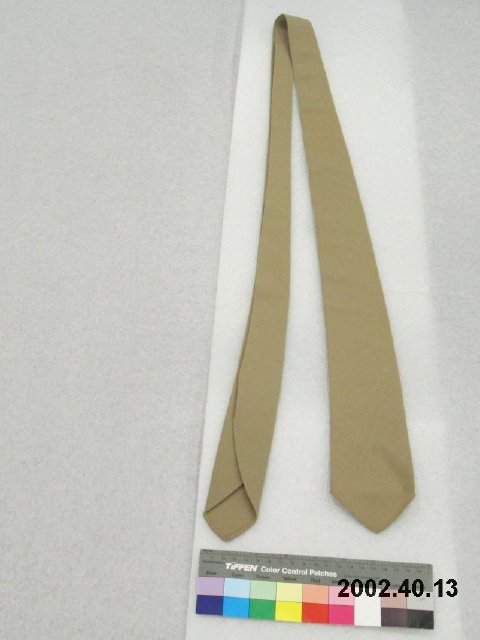I’ve been thinking a lot about the off-white tie found in the suitcase the Somerton Man famously left at Adelaide’s railway station. Only an American gangster (or perhaps poor old Hector St Clair) would have a white tie to go with his black shirt: and what we’re looking at isn’t even a white tie, it’s an off-white tie. Oh, and the Somerton Man didn’t even have a black shirt in his suitcase.
The tie also looks to me as though it was a working tie, i.e. an item worn many times not for show, but for use, for practicality. Any maker’s tag attached to the back of the tie had been long lost by 1948: but, as far as I can tell, there were no actual jobs in 1948 that required you to wear a white / off-white tie.
So, if the tie was of no practical use to the Somerton Man in 1948, why was he carrying it around in his suitcase? What possible value could it have had?
One answer I’ve been circling around for a while is that the tie might have been something that the Somerton Man had worn regularly some years earlier, but which still had some sentimental or nostalgic value for him.
Hence, I’m wondering whether the right questions to be asking of his off-white tie might be more to do with the reasons he had been wearing it 10 or even 20 years before 1948, say from 1930 onwards. Might it have been connected with some kind of peak experience for him?
A beige tie, perhaps?
This also begs the question of what the tie’s colour originally was, before it had been (largely) washed out. The tie famously appears close to the end of Part 1 of the 1978 Littlemore documentary, and I think you can see a tinge of faded colour to it.
A Google search does bring up a handful of beige ties, most notably for the Queen’s Own Rifles of Canada. But Captain Flavelle’s (apparently 100% woollen) beige tie from WWI seems the wrong kind of material completely:
This makes me wonder whether the fabric used to make the Somerton Man’s tie might help us to date it.
But there’s something about the way only a single person (front row, fifth from right) in the following 1956 QOR Sergeants’ Mess is wearing a beige tie that strikes a distant chord:
Who is that person at the front, and why was he wearing a beige tie? Not being a specialist Army historian, I have no easy way of knowing if this is signalling some specific Army role (perhaps in Canada, or in the British Army).
A U.S. Army necktie?
However, if you search not for (the British) “tie” but for (the American) “necktie”, you’ll get a quite different set of results. For example, even Gran’ma Wikipedia’s page on U.S. Army clothes starts becoming vaguely relevant (for a pleasant change):
In 1941, the necktie for the winter uniform was black wool and the summer necktie was khaki cotton.[4] In February 1942, a universal mohair wool necktie in olive drab shade no. 3 (OD 3) replaced both previous neckties. The OD 3 necktie was shortly superseded by a khaki cotton–wool blend necktie. […]
Officers wore black and khaki neckties with winter and summer uniforms respectively, like enlisted soldiers, until after February 1942 when the universal neckties were changed to khaki for all ranks.
A little more searching turned up that the US Army necktie came in three colours (AKA “colors”): khaki, tan, and mustard. And one problem with nailing down the precise colours these were is that the Internet seems to be flooded by reproduction US Army apparel. (As if the world really needs a load of people pretending to be WWII-era US soldiers wearing modern poly/cotton mix fabrics.)
However, the Kentucky Historical Society’s archives does have some good kit in its holdings. This item is a 1940 machine-stitched US Army khaki cotton necktie:
Similarly, the following is a United States Marine Corps khaki tropical necktie from 1937, folded and machine stitched:
Given that the first one of these two has a centre seam but the second one is folded, it’s hard to extrapolate much further on this as far as seams go. The material looks completely wrong too.
In short, while I am quite sympathetic to the suggestion that the Keane tie might have been a non-standard-issue Army dress tie that helped denote rank (say, as part of a mess uniform), I struggle to match the quality of its weave with the (frankly rather poorly put together) standard-issue US Army ties I’ve seen on the web. I also can’t satisfactorily match its colour with the ties I’ve seen, even if you try to argue it was faded. So I’m still very much open to suggestions as to where to take this next.
A Material World
Given that it seems to be a tie constructed in the modern way (as devised in 1922 and then later patented by Jesse Langsdorf in New York), we might generally date it to about 1930 or later, and perhaps place it more in North America than in the UK. There’s a nice visual overview of 20th century tie history here.
However, perhaps we’re still putting the cart before the horse, and we should instead determine the precise material that was used to make the tie, because that might help narrow the search down significantly.
Even though I think a close look at the tie rules out silk, viscose/rayon, and veltet, we’re still left with cotton, linen and wool: and arguably the most likely seems a mix of the three (i.e. where the warp and weft use different kinds of thread). Moreover, because it looks only a little ‘fluffy’, I think we can rule out its having been 100% wool.
My thoughts? Given that linen doesn’t hold its colour as well as cotton, I suspect that this was a linen-cotton mix. Yet given the bold designs of most ties of the era, its plainness still seems somewhat unsettling to me: I can’t help but wonder whether we’re missing something really obvious about this tie.
Perhaps what you’d really want here is some marvellous V&A mid-century textile specialist to help you identify the material. The next-best thing might be the following extremely helpful V&A guide to textile identification that gets you frustratingly close. If you want something a little more hands-on, the Vintage Fashion Guild has an online fabric resource that you might find more practical.
“I’ll Drink To That”
Perhaps what we instead need is a tie collector to steer us through these rapids. But wait! Here’s a British Pathé short from 1955 called “Tie Collecting aka Tie Cutting AKA Tie Collector”, featuring Alan Course (landlord of The Bear Inn in Oxford):
In fact, The Bear Inn and its collection of four and half thousand tie clippings is (according to Atlas Obscura) still there, and (allegedly) serving an excellent portion of bangers and mash in its (newly re-opened) beer garden. Can there ever have been a pub more worthy of a research visit?





I read the tie as ” T.Kean J.R. ”
Searching, I found this :
https://www.woburnma.gov › uploads › 2017/05
PDF
WORLD WAR II, 1941-. 1945. # of Names on List. 4360. Last Name. First Name. Middle. KIA *. ABREU. GEORGE. W. ABREU. JOAQUIN. J. ABREU. JOHN. F.
On the .pdf file lists Kean, Jr. Thomas V.
Unfortunately, this link doesn’t provide any more information.
If not off-white, then what about mustard as in Keen’s, or a lighter shade of puke?
john sanders: neither will cut the mustard.
NIck Pelling: If you’re not Keen on mustard what about custard; close as you can get to off-what I’d expect.
Good evening super sleuthers!
[bla bla bla] Jessica Harkness [bla bla bla] lesbian lover [bla bla bla] nappy [bla bla bla] shit [bla bla bla] Torah [bla bla bla] flaccid mummified cock [bla bla bla] ate it with full Jewish funeral rights. [bla bla bla]
The Somerton man’s tie is a tweed-style worsted tie, made of threads of distinctly different tone and – assuming it cut on the bias as most ties were – has a warp of one and a weft of the other. For technical reasons, if it were made in Australia, I’d expect merino for the weft and something like a Lincoln-merino cross for the warp.
Nice pic of two-tone worsted here
bespokeedge com/blog/what-is-worsted-wool
This isn’t – not in the least – the sort of fabric used for military ties. Your own examples will do to show they were bring woven with a small, even, tabby weave (by tabby I mean single over-and-under weave which is not e.g. twill), and they were made all with fibre dyed to the same tone – and pretty much same gauge fibre for both warp and weft.
I should also think that so soon after WWII there’d have been very few adults (let alone police officers) who would fail to recognise any piece of ex-military uniform, no matter how sun-faded.
On all counts, I’m afraid Nick, the ‘military tie’ idea is a total bust, the best I could say being that both fabrics might be described – a bit vaguely – as worsted.
Admittedly, industrial archaeology includes study of manufactured fabrics as well as other materials and products, but this isn’t difficult information to acquire so I won’t add more references.
A volume I’ve found enormously helpful for the history of weaving and woven fabrics (helping pin-point likely origin for those we find in medieval artefacts) was written by Agnes Geijer. Bit hard to find now, but there is a lot about the history of industry around, especially those written by important manufacturies. Just in case anyone wants to double check tie-fabrics.
PS – I neglected to say that the Somerton man’s tie certainly, and all military ties that I’ve seen from WWII English-speaking world military ties were woven from wool. The type of wool and whether/how carded and combed before weaving gives you the difference between the ‘fluffier’ and harder-smoother look of true worsted. The reason the police officer called it ‘off-white’ is that the white weft is visually dominant, so the grey warp makes it appear only less-than-white. I should have called it very pale grey.
D: I agree holeheartedly on the tie (merci me). A bit flash in the weft by military uniform standards, even for orficers from my understanding of the type. I’m fine with the Lincoln-Merino cross too though I’d stipulate a come back on the merino side and I’ll add that we could be looking at a natural unbleached end product.
I guess most sheep shaggers following will be aware that Mt. Gambier be home to long fleeced Lincolns in South Australia so no coincidence that Onkaparinga mills set their looms for the type. Apart from WW1 & 2 Army blanket contracts for which they made their name, the company were also into fancy tartan weaves familiar to our kilted Highland clansfolk. As for wool ties, none appear in their ‘cattledogs’ but didn’t someone say that SM’s tartan scarf carried the Onkaparinga label?…
Just checking for clues relevant to any rehash we may be about to encounter. I think contributor D made a good point on warp & weft patternation with my last post describing unbleched wool blend and the Keane tie’s neutral colour as opposed to white, which it plainly isn’t, be worthy of more consideration imho.
why would Jack Keane own a white tie?
Could Carl Web have been in invited to some secret club/illegal gambling where the identifer like a password was a white tie
@Em
didn’t Keane train as a pilot in Canada? Could it be something the cadets wore in Canada?